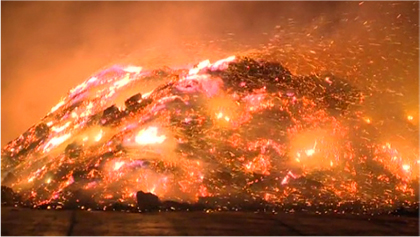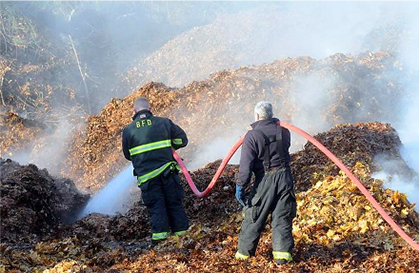Craig Coker
The main factors causing SC fires are: biological activity; relatively dry compost piles; larger and more well-insulated piles (compost and composting feedstocks are good insulators and are more insulating as they dry out); limited air flow and reduced free air space; poor moisture distribution (the critical moisture content that supports SC is 25%-40%); a nonuniform mix of materials; and poor or incomplete temperature monitoring. These precursor conditions are more likely found in storage piles of unprocessed feedstocks, curing piles and product storage piles — all less likely to be closely monitored than active composting piles and which rely more on passive aeration than forced aeration.
Detecting SC Fires

Compost fire Austin, TX 2013
SC fires are smoldering fires that usually start deep within a compost or storage pile and may go undetected for a while. These types of internal fires call for a very different response than external fires. Piles of composting or composted materials often form “macropores” or vents that allow heat to escape and oxygen to enter (which can feed a SC fire). Vents can be identified in the cooler times of the day when the condensing mist from the vent shows up most easily. As the mist emerges from the pile, condensation on the surface discolors the compost around the vent. Sometimes, mushrooms may be growing there. Walk the top of your piles weekly and look for these vents. Insert your temperature probe right down into the vent to look for excessive temperatures as an early warning sign (Naylor, 2004).
For systems with mechanical aeration, operators are trained to turn up the aeration system to cool off a pile. However, if the temperatures in the pile are already high, adding more air might stimulate SC and hasten the fire. If a temperature reading above 93°C (200°F) is observed, the aeration system should be shut down and the material removed from the pile (Rynk, 2000b).
Extinguishing The Fire
In storage piles that lack mechanical aeration, the only option is to physically disturb the pile to promote cooling. When temperatures reach 82° to 93°C (180°-200°F), break apart the piles into smaller piles, and have water available to quench any embers or flames that might flare up from the increase in oxygen to the SC embers. One method is to use a loader to cut a trench through the pile. This increases the piles’ surface area, which increases the amount of area for heat loss and changes the airflow pattern inside the pile (Rynk, 2000b). But again, have water ready in case flames break out.
SC fires are most effectively extinguished by breaking a pile down and spreading the materials out in a layer about 6-inches to 8-inches thick (the author has done this by “back-blading” with the loader bucket). Have another person soak the thinner layer with water as the loader backs up. Obviously, this requires a fair amount of space. A good fire prevention practice is to look at your site with a critical eye and imagine trying to break down large piles and spread them out. If it looks like you might not have room to do that, you need to reduce inventories and clear some space.

Compost fire Milford, CT 2014
It is always a good idea to meet with your local fire department and agree on procedures for handling a SC fire, particularly if it is observed after hours and they get called first. Most fire departments will try to soak down a big pile from the top, which rarely works. One reason is that there is simply too much material and heat, and not enough water. Another is that compost piles shed water after the first 2 to 3 inches of the pile get saturated, so water never drains down into the burning embers inside the pile.
Smothering a SC burning pile with dirt to deprive the fire of oxygen will only work if the now-covered pile can be allowed to sit undisturbed for a long time. Even without oxygen, the pile will continue to burn or char due to chemical reactions. At high temperatures in a woody pile, the woody materials will undergo hydrolysis (the breaking of chemical bonds with water, releasing heat in the process). This hydrolytic action will form acetic and formic acids, which will lower the ignition temperature of the woody materials (Rynk, 2000b).
Commonsense Rules For Fire Prevention
Here are some commonsense rules to prevent SC fires (Naylor, 2004):
- Rule #1. Set up a meeting with your local fire department. Discuss compost fires, and agree on guidelines on how to handle compost fires once they begin. Have the correct firefighting gear on site. If your site is remote, a runoff pond can serve as source of water for the composting process as well as for firefighting.
- Rule #2. Assure adequate ventilation of the pile to release heat and increase evaporation of water, a heat absorbing process. Ventilation can be achieved by turning the pile or using a mechanical aeration system. Ventilation can also be improved by constructing narrower, shallower windrows or piles, generally less than 6-feet deep.
- Rule #3. Avoid pile depths greater than 12-feet, and watch for vents in deep piles. Use these vents to monitor internal pile temperatures.
- Rule #4. Locate the hot spot before it turns into a fire. Monitor temperature of all piles on a weekly basis, seeking out the hottest spot in the pile. For this proactive monitoring, we are totally uninterested in the average pile temperature (a useless bit of information at this point). We need to know the hottest spot in the pile.
- Rule #5. If you have a fire, it needs to be located in the pile. That is usually accomplished by very carefully using a large wheel loader to open up the pile. A fire hose should be available as the loader removes material to spray directly onto burning embers – or a burning loader. The fire department or an in-house fire brigade should be on stand-by as the pile is opened. Don’t underestimate the damage — physical or political — a smoky fire can do.
- Rule #6. As Smokey the Bear knows best, only you can prevent [compost] fires. Prevention is the only adequate solution to avoiding dangerous and expensive fires at composting facilities.
Craig Coker is a Senior Editor at BioCycle CONNECT and a Principal in the firm Coker Composting & Consulting, near Roanoke VA.













